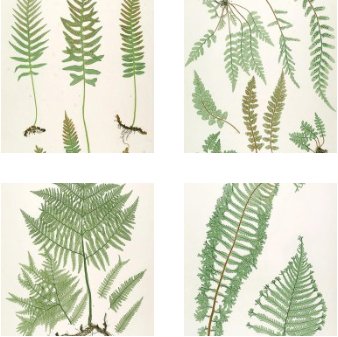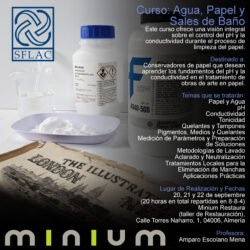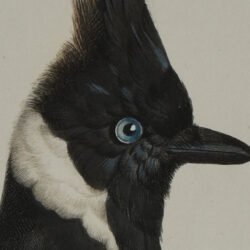Nature Prints? Do you remember that time at school when the teacher told you to collect some plant leaves from the backyard to later carefully lay them between newspapers pages, pressing them afterwards with old, heavy phonebooks?
Well, a couple of weeks ago, a client came to South Florida Art Conservation with something that, at the very beginning looked like the pages of a herbarium. Soon, a careful examination revealed that they were not just a flattened plants but some extremely realistic nature prints.
The first print we examined was titled “ASPLENIUM TRICHOMANES”, marked at the upper right as “PLATE XXXIX”, and at the bottom left an inscription that said “NATURE PRINTING”. Also, under the title, at the bottom center, another inscription claimed the name of the authors stating“PRINTED BY BRADBURY AND EVANS, WHITEFRIARS, LONDON”. All that data gave us enough information to initiate some research over the internet; what at the very beginning appeared to be the pages of a herbarium resulted in being some pages of an illustrated book titled “The Ferns of Great Britain and Ireland” by Thomas Moore, edited by John Lindley, and “nature printed” by Henry Bradbury.
On the preface of such book, Lindlay states,
“A draughtsman can do no more than to delineate a part of what he sees, and whether he sees correctly what he delineates, will at all times be a matter of doubt, especially where, as in natural history, accuracy is indispensable”
And follows:
“To express such facts with the necessary accuracy, the art of a Talbot or a Daguerre, was insufficient, nor could they be represented pictorially until NATURE-PRINTING was brought to its present state of perfection.”
Nature prints, indeed reproduce in an extremely accurate way, every detail of the selected plant, and more than just a pictorial representation, it adds as well, a three dimensional quality to it. But, How where these prints made?
- Detail 1
- Detail 2
- Detail taken with raking light
We found the answer to this question in a book written by Alois Auer, titled “Discovery of the Natural Printing Process: An Invention”. Other than a printer, inventor and botanical illustrator, Auer was the director of the Austrian printing house. As per the book, the patent of this invention was from October 12th, 1852, and at the very beginning of the book, Auer gives a brief explanation of the complete process:
"The original, be a plant, a flower, or an insect, a material of texture, in short any lifeless object whatever, it is passed between a copper-plate and a lead-plate, through two rollers that are closely screwed together.
The original, by means of pressure, leaves its image impressed with all its peculiar delicacies -with its whole surface as it were- on the lead plate.
If the colors are applied to this stamped lead-plate, as in printing a copper plate, a copy in the most varying colors, bearing a striking resemblance to the original, is obtained by means of one single impression of each plate.
If a greater number of copies are required, which the lead-form on account of its softness is not capable of furnishing, it is stereotyped in the case of being printed at typographical press, or galvanized in the case of being worked at the copper-plate press, as many times as necessary, and the impressions are taken from the stereotyped or galvanized plate instead of from the lead-plate.
Originals, that dare not be injured, must be covered with gutta percha, which form of gutta percha when removed from the original is covered with a solution of silver to render it available for a matrice for galvanic multiplication.”
It continues stating the following:
“Production in the shortest space of time, unsurpassable resemblance to the original, unlimited number, and economic production are the most important qualities of this process which has been discovered in the Imperial Court and government printing office."
It is a known fact that Henry Bradbury, the author of the prints our client brought to us, travelled to Vienna and learned from Auer this particular printing technique which he later applied, very successfully, in the book titled “The Ferns of Great Britain and Ireland”
- Paper Conservation
Even if Auer considers nature prints to be his own invention, some other sources attribute it to Benjamin Franklin or his friend, a naturalist called Joseph Breintnall who made contact nature prints from leaves around 1730. But that kind of contact prints made with plant leaves appear in different manuscripts much earlier than that. Some examples can be found in the Salzburg Ms. (around 1425) or Codex Atlanticus (around 1500).
The reality is that, as Karen M. Reeds proclaims in "Leonardo da Vinci and Botanical Illustration: Drawing, Nature Printing, and Printing circa 1500"
"Making a nature print is a child's play: a leaf (or less commonly a flower or a whole plant) is inked on its underside and pressed directly onto the page to illustrate itself. Its imprint preserves the specimen's individual irregularities of outline, surface texture, and venation. Unlike illuminating a manuscript or cutting a wood block, making a nature print takes no special training, talent or equipment - only a certain deftness of hand.”
Nature prints origins are directly related to nature itself in the fossils found with the ghosts of leaves, fishes or other animals, and to claim that this or that artist was the creator of the first nature prints is impossible. What is sure is that Alois Auer invention brought nature prints to a state where the original is reproduced with a fidelity unmatched before and that the prints of Bradbury and Evans included in “The Ferns of Great Britain and Ireland” are of an exceptional beauty and quality.
ASPLENIUM TRICHOMANES, PLATE XXXIX
Before and after conservation treatment
Bibliography:
Moore, T., Bradbury, H., & Lindley, J. (1857). The ferns of Great Britain and Ireland. London: Publ. by Bradbury and Evans.
https://www.biodiversitylibrary.org/bibliography/416#/summary retrieved on July 4th, 2018.
Welsbach, L. A. (1853). The discovery of the natural printing process, an invention for creating by means of the original itself…. Vienna: Imperial Court and Gov. Print. Off.
https://goo.gl/jUPNR8 retrieved on July 4th, 2018.
Reeds, K. M. (2006). “Leonardo da Vinci and Botanical Illustration: Drawing, Nature Printing, and Printing circa 1500." pp 205-237, in Visualizing Medieval Medicine and Natural History, 1200–1550, ed. Jean A. Givens, Karen M. Reeds, Alain Touwaide. (AVISTA Studies in the History of Medieval Technology, Science and Art, pp. 205-237). Vermont, VT: Ashgate.
Cave, R. (2010). Impressions of nature: A history of nature printing. London: The British Library.
























2 Responses